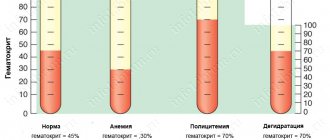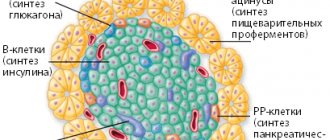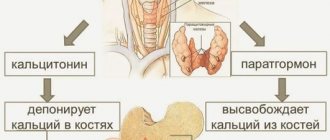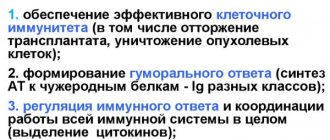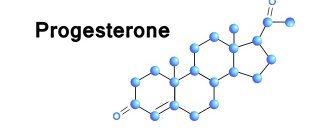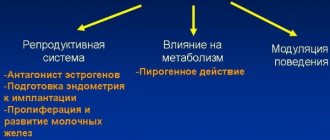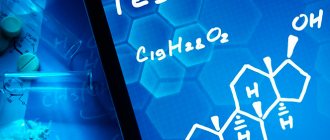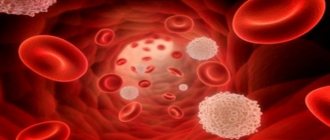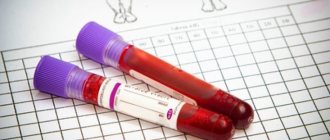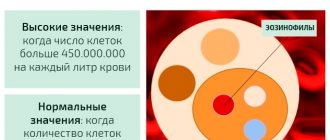17-OH-progesterone is a steroid hormone that is synthesized from progesterone and 17-hydroxypregnenolone. It is produced by the corpus luteum of the ovaries and the adrenal cortex. This hormone is an intermediate product of cortisol synthesis.
17-OH-progesterone levels are associated with stress, fear and mental stress
The amount of 17-OH-progesterone increases in the human body during stress, mental stress, fear or anger. When you find yourself in a dangerous situation, it is this hormone that causes blood to flow to the muscles and heart. It is also responsible for increased blood pressure and arrhythmia.
Functions in the body
17 OH-Progesterone is a sex hormone that affects the functioning of the internal genital organs.
If a woman’s indicators of this steroid are within normal limits, then it fully performs the following physiological functions:
- regulates the phases of the menstrual cycle (different concentrations of the sex hormone are recorded on different days, which can increase sharply and then decrease again to minimum levels);
- takes part in the process of puberty (increasing the level of steroid hormone in teenage girls, ensuring the full development of the internal genital organs and the formation of reproductive function);
- in combination with the biochemical activity of other sex hormones, it promotes the maturation of the egg and its release into the uterine cavity (this is an important function of the steroid hormone, without which it is impossible to conceive a child);
- acts as a regulator of the process of gestation, its stable development in the womb and birth after 9 months.
- participates in processes that are aimed at the biochemical reactions of 17 OH-Progesterone with other steroid hormones necessary to maintain the stable function of the female reproductive system.
If there were no hormonal activity of 17 OH-Progesterone in the body, women would not have a stable menstrual cycle, and it would be impossible to conceive, bear and give birth to a healthy child on time.
Most common symptoms
Regardless of the source of hyperandrogenism (that is, an increase in the amount of male sex hormones), clinical manifestations include:
- 1 Hirsutism is the appearance of hair in unwanted places (on the face, chest, arms, thighs, buttocks, near the nipples). The so-called shaft hair grows (dense, thick, brightly pigmented).
- 2 Disorders of the menstrual cycle according to the type of hypomenstrual syndrome: from oligomenorrhea (scanty, infrequent menstruation) to amenorrhea (absence of menstruation for a year or more).
- 3 Absence of pregnancy , and if it occurs, spontaneous termination in the early stages (frozen pregnancy is more often diagnosed).
- 4 Excessive hair growth on the legs , back, and forearms.
- 5 With a long course of the disease, virilization syndrome appears. In women it manifests itself as deepening of the voice, baldness, and enlargement of the clitoris.
The severity of the above symptoms depends on the level of androgens in the body and the duration of the disease.
How and under what conditions is it produced?
17 OH-Progesterone (the norm in women is determined by a biochemical study of venous blood) is a female sex hormone, which is a product of the metabolic synthesis of the steroids progesterone and 17-hydroxypregenolone.
In the largest quantities, 17 OH-Progesterone is produced by the adrenal glands and, together with the blood flow, spreads through the tissues of the internal organs, and also ensures the regulation of the functions of the organs of the reproductive system.
Under the influence of metabolic processes, the residual part of 17 OH-Progesterone, which is preserved in the adrenal tissues, enters into a chemical interaction with the substance 21-hydroxylase and 11-b-hydroxylase. The steroid is then converted into cortisol, which is also used by the female body for the stable functioning of the reproductive organs.
Depending on the state of the female body and the phase of the menstrual cycle, 17 OH-Progesterone can also be converted into another hormonal substance - androstenedione, which is a precursor of estradiol and testosterone.
In addition to adrenal tissue, 17 OH-Progesterone is produced by the ovaries. The secretory activity of these endocrine glands occurs in the first 1-2 days of the menstrual cycle. Then the appendages practically stop producing this steroid, and its main synthesis is carried out by the tissues of the adrenal glands.
In the morning, the concentration of the hormone is highest. Throughout the day, the level of the steroid decreases, but remains stable. At night, the concentration of 17 OH-Progesterone is lowest due to a decrease in the activity of the adrenal glands and organs of the female reproductive system.
After the conception of the child has occurred, the active development of the fetus has begun, and the synthesis of the steroid hormone also begins to be carried out by the placenta. The concentration of 17OH-Progesterone varies depending on the trimester of pregnancy. At different periods of fetal development, the level of this hormone is monitored by doctors during routine examinations of the woman.
A decrease in steroid concentrations during pregnancy may indicate a pathological condition of the placenta.
In girls who were born prematurely, a high level of 17 OH-Progesterone is recorded in the blood serum. During the first 7 days of independent life, the steroid concentration returns to normal, and the use of special medications is not required. In children born on time, such reactions of the body practically do not occur.
Before the onset of puberty, 17 OH-Progesterone is produced in small quantities. Its concentration increases sharply when a girl reaches the age of 11-12 years.
This is a period of active formation of the internal genital organs, as well as the acquisition of reproductive function. The maximum level of the steroid is recorded in adulthood, when a woman begins to be sexually active and has a stable menstrual cycle.
Deviation correction methods
Before carrying out therapy, it is necessary to find out the cause of the fluctuations. If this is not done, then serious complications may develop from taking incorrectly selected hormone-containing drugs.
All medications must be prescribed by highly specialized specialists, according to individually developed regimens.
To reduce the concentration of the substance, combination therapy is prescribed. If the increased rate is a consequence of tumor processes, then patients undergo surgical removal of the tumors followed by drug treatment.
To increase the concentration of hydroxyprogesterone, hormone replacement therapy, including progesterone preparations, is used. Injections of pure progesterone can be administered intramuscularly for ten days.
Indicator table is normal
17 OH-Progesterone (the norm for women is established through a comprehensive examination in a biochemical laboratory) is a sex hormone, the concentration of which varies depending on the age of the patient, the phase of the menstrual cycle, the presence of concomitant diseases of the reproductive system, and the trimester of pregnancy.
The table below shows the steroid hormone norms for the female body:
| Age, phase of the menstrual cycle, period of fetal development during pregnancy | Normal indicators (unit of measurement ng/ml) |
| Child up to 2 months old. | From 0.96 to 10.46 |
| Children aged from 2 months. up to 1 year | From 0.66 to 2.81 |
| Indicators for a child aged 1 to 10 years | From 0.2 to 0.8 |
| Indicators for girls aged 11 to 17 years, taking into account the period of puberty according to the Tanner scale | Stage 1 of sexual development – from 0.03 to 0.9 Stage 2 of sexual development – from 0.05 to 1.15 Stage 3 of sexual development – from 0.1 to 1.38 Stage 4 of sexual development – from 0.29 to 1.8 Stage 5 of sexual development – from 0.24 to 1.75 |
| Adult women aged 18 to 59 years, taking into account the phase of the menstrual cycle | Follicular phase – from 0.4 to 1.51 Luteal phase from 1.00 to 4.51 |
| Normal indicators for women aged 60 years and older who are postmenopausal | From 0.13 to 0.51 |
| From 1 to 6 weeks of pregnancy | From 1.32 to 3.30 |
| From 7 to 14 weeks of pregnancy | From 1.1 to 2.8 |
| From 15 to 24 weeks of pregnancy | From 1.65 to 4.62 |
| From 25 to 33 weeks of pregnancy | From 1.98 to 10.2 |
| From 34 to 40 weeks of pregnancy | From 2.64 to 13.20 |
The above indicators of the normal level of 17 OH-Progesterone are typical for women of a specific age group, phase of the menstrual cycle and pregnancy period. They are taken into account by doctors during a comprehensive diagnosis of the body, determining the performance of adrenal tissue and the level of female sex hormones.
Symptoms of increase and decrease
17 OH-Progesterone (the norm in women is determined by conducting a biochemical blood test) is a steroid hormone, an increase in the concentration of which is manifested by the following symptoms:
- various irregularities of the menstrual cycle, which can be expressed in too much discharge, prolonged periods;
- a feeling of aching or nagging pain that is localized in the lower abdomen;
- inflammation of the uterine appendages, the development of which is accompanied by pain from the lumbar spine;
- inability to conceive a child (in medical practice there are clinical cases where too high a concentration of steroid hormone was manifested exclusively by this symptom);
- dysfunction of the adrenal cortex, which entails the development of other diseases associated with disruption of the functioning of this organ;
- decreased libido, which can occur in women of various age groups.
A decrease in the level of 17 OH-Progesterone is accompanied by symptoms that superficially resemble the signs of Addison's disease.
A woman experiences the following pathological conditions of the body:
- a feeling of chronic fatigue, which gets worse over time;
- nausea and severe vomiting;
- increased irritability, causeless outbursts of rage and anger;
- hyperpigmentation of the skin with the greatest formation of spots in areas that are exposed to sunlight;
- prolonged bouts of depression;
- a persistent feeling of thirst with copious fluid intake (this symptom is mistakenly confused with the manifestation of the first signs of diabetes);
- increasing weakness in muscle fibers, which intensifies after attempting to perform any energy-consuming activities;
- rapid loss of body weight;
- lack of appetite, which periodically changes to a strong feeling of hunger with a craving for sour and salty foods;
- the development of orthostatic hypotension, when a woman suffers from too low blood pressure, which drops even lower after trying to get out of bed and take a standing position;
- increased potassium concentration in the blood;
- decreased sensitivity of the lower extremities, which is a complication of hormonal imbalance;
- violation of the digestive function of the gastrointestinal tract and diarrhea;
- periodically occurring tremor of the upper limbs and head, which intensifies at the moment of excitement;
- an inexplicable feeling of anxiety and restlessness that occurs suddenly and then goes away in the same way without taking sedatives;
- disturbance of the rhythmic activity of the heart, which most often manifests itself in the form of tachycardia;
- increased level of eosinophils in the blood;
- increased amount of urine excreted;
- a decrease in blood glucose concentration and the appearance of signs of hypoglycemia;
- irregular periods, or complete disappearance of menstruation;
- violation of the reproductive function of the body and the inability to conceive a child;
- dehydration of the body due to excessive consumption of fluid, which is almost immediately excreted by the kidneys in the form of urine.
All of the above symptoms of a decrease in the level of 17 OH-Progesterone have varying severity depending on how low the concentration of the steroid hormone is. It is believed that a decrease in the level of steroid hormone carries much more dangers than an increase in the concentration of 17 OH-Progesterone.
Consequences of elevated hormone levels
If the hormone level differs from normal for a long time, the following consequences may develop:
- type 2 diabetes mellitus;
- atherosclerosis;
- diseases of the heart and blood vessels;
- depressive states;
- mental disorders;
- peptic ulcer;
- encephalopathy;
- cerebrovascular accident.
Excess of the hormone has a negative effect on brain activity. It inhibits the receptors that are responsible for taste perception, as well as some other senses.
Reasons for promotion and demotion
17 OH-Progesterone (the norm in women is established based on the results of diagnosing female hormonal levels) is a steroid hormone, a decrease in the level of which can be caused by the presence of the following diseases or pathological conditions of the body:
- congenital adrenal insufficiency (this pathology is associated with anomalies in the intrauterine formation of the fetus, when the tissues of the organ do not receive full development, and after the birth of the child do not perform their physiological functions in the synthesis of the hormone 17 OH-Progesterone);
- diagnosing a woman with Addison's disease, which occurs in a chronic or acute form;
- benign and oncological neoplasms that are localized in the tissues of the adrenal glands, disrupt the functioning of the organ, and lead to a complete absence or significant decrease in the production of steroid hormones;
- intoxication of the body with salts of heavy metals or chemical compounds, the active substances of which lead to the destruction of adrenal tissue;
- a hereditary feature of the body when the endocrine glands do not provide the body with a sufficient amount of the hormone 17 OH-Progesterone (this reason for the reduced level of the steroid is one of the most common).
An increase in hormone concentration is also a pathology that requires elimination by taking medications, surgical treatment or lifestyle adjustments.
Too high levels of 17 OH-Progesterone can be caused by the following reasons:
- primary or secondary infertility, acquired as a result of previously suffered diseases of the reproductive system organs, which caused their dysfunction;
- benign and cancerous tumors of the ovaries, as well as other appendages of the uterus;
- temporary disturbance of the menstrual cycle due to the influence of various factors (if this is the case, the increase in the level of steroid hormone is short-term, and the problem itself is eliminated immediately after stabilization of the cycle);
- hyperplasia of the adrenal cortex, which was acquired during intrauterine development of the fetus.
An increased level of 17 OH-Progesterone is most dangerous because the hormonal substance can cause early sexual development in girls and lead to disturbances in the functioning of the organs of the reproductive system. Determining the causes of hormonal imbalance is the main task during the organization of quality treatment.
Symptoms of elevated 17 OH progesterone
You can suspect a violation of its production based on the following signs:
- Excessive growth of body hair and its simultaneous thinning;
- Irregular menstruation (dysmenorrhea) or complete absence (amenorrhea);
- Acne (blackheads);
- Impaired blood glucose levels.
If left untreated, such conditions can lead to insulin resistance, diabetes, high blood pressure (hypertension), increased cholesterol in the blood, and heart problems.
It is worth noting that rashes and pimples are the most common symptoms of excessive synthesis of 17OH progesterone. However, they pass when the hormonal levels stabilize. But with dermatological treatment alone, this problem cannot be eliminated.
Indications for the study
An analysis of the level of 17 OH-Progesterone is indicated for women who have the following health problems:
- menstrual irregularities;
- all types of adrenal tumors;
- hirsutism;
- impossibility of conceiving a child;
- deficiency of substances 11-hydroxylase and 21-hydroxylase;
- manifestations of imbalance of female sex hormones;
- decreased sex drive.
Indications for testing the level of steroid hormone are determined by a gynecologist or endocrinologist who examines and treats the patient.
Useful video
Watch this video about the treatment of congenital adrenal hyperplasia:
Similar articles
- Analysis for hormones in women: which ones are taken, how, when...
Sometimes it is necessary to take a hormone test in women in order to identify the problem of infertility and poor health. Which ones are taken when planning a pregnancy, after 40, during menopause? When and how should this be done? Decoding will help you understand the result. Read more - Menstruation after Duphaston: how it goes when taking it and after...
It’s quite possible for your periods to go wrong after Duphaston due to changes in your body. However, this may also indicate an incorrectly selected dose of the drug, pathology, or other problems. Why didn't they come on time? Is it normal if they came earlier and were heavy and painful? Read more
- Hormones during menstruation | Progesterone
Throughout the menstrual cycle, certain hormones predominate. They are responsible for ovulation, the ability to conceive, as well as general problems. What are the hormones during menstruation? Read more
- Progesterone injections to induce menstruation
You cannot give progesterone injections to induce menstruation on your own, only in consultation with your doctor. They improve the cycle and also promote conception. In each case, the dosage regimen is different. Read more
How to determine
Determination of the level of 17 OH-Progesterone is carried out in a laboratory that is equipped with all the necessary material and technical resources for conducting this type of research. Venous blood is used as a biological material, which is subject to biochemical analysis.
The average duration of a diagnostic procedure is from 3 to 8 hours. This type of research is carried out in private and public health care institutions. The average cost of analysis is 1500-2000 rubles.
Preparing and conducting analysis
The study of venous blood for the level of 17 OH-Progesterone does not require complex preparation procedures. The basic rule for collecting biological material and obtaining the most reliable data is to collect venous blood on days 3-5 of the menstrual cycle.
During this time period, the concentration of the steroid hormone is optimal, and any changes in its level, down or up, will be determined using laboratory testing.
Venous blood donation is carried out in the morning between 8 and 11 o’clock. The last meal should take place no later than 8 hours before visiting the laboratory.
On the eve of the analysis, it is prohibited to consume alcoholic beverages, drugs and hormonal medications. If a woman is taking any other medications, she should notify her doctor and the specialist who draws the blood.
Increase progesterone 17 OH naturally
Therapy should be selected only by a specialist. It usually involves conservative methods, but when, for example, tumors are detected, surgical intervention is used. Drug therapy, after consultation with a doctor, can be supplemented with traditional recipes. Various decoctions and infusions that have progestogenic properties are used as the latter.
Most often, raspberries, plantain, and cuff are used for these purposes.
- Brew raspberry leaves as tea. Drink the resulting product throughout the day at regular intervals in small portions;
- Mix dry raspberry leaves with wild yam in equal proportions. Brew a tablespoon of the mixture in a glass of boiling water for 3 hours. After straining, drink 15 ml before each meal (three times a day);
- Mix 1 tsp. plantain seeds and twice as much mantle. Pour boiling water (1/4 l) over the plants and let stand for 1-2 hours, and then strain. A glass of product is divided into three doses;
- Pour ½ liter of hot water 2 tbsp. l. twig fruits, stand for 2-3 hours. Drink throughout the day;
- Mix a liter of vodka and 100 g of red brush, leave for a month, shaking occasionally. Take 2 ½ tbsp three times a day before meals. l. You can dilute the tincture with water;
- Infuse a tablespoon of astragalus root with water or vodka. First recipe: pour ½ liter of boiling water over the crushed root and leave for 30 minutes. Drink 1/3 glass three times a day after meals. Second recipe: pour 40 g of root with 400 ml of vodka, leave for 10 days. Drink 1 tbsp before meals. l. 2-3 times a day;
- Baikal skullcap (100 g of crushed roots) pour ½ liter of vodka or alcohol in a glass container. Cover the mixture with a lid and leave for a month. After this, drink 30 drops three times a day;
- Ortilia is one-sided. For the tincture you will need 50 g of the plant and ½ liter of vodka. After mixing, the product is infused for 2 weeks. At the end of the specified time, take 30 drops before meals three times a day. Ready-made infusion can also be purchased at the pharmacy.
Before using traditional medicine recipes, you need to make sure that you are not allergic to them, as some herbs have contraindications. This will eliminate unwanted consequences after using them.
Decoctions and infusions are taken starting from the middle of the cycle. The medication is taken for a maximum of 10 days in a row, and then a break is taken until the middle of the next cycle.
Decoding the results
In order to independently decipher the results of a biochemical analysis of venous blood for the level of 17 OH-Progesterone, you need to obtain the results of a laboratory test and compare its contents with normal values.
In this case, one should take into account the phase of the menstrual cycle during which the blood was taken, the woman’s age, and the presence or absence of pregnancy. A decrease or increase in the concentration of a steroid hormone is a reason to visit an endocrinologist, gynecologist, and a comprehensive examination of the adrenal glands, ovaries and other organs of the female reproductive system.
Reduced 17OH progesterone
The reasons for this phenomenon may be hidden in chronic diseases of the genitourinary system or taking a number of medications (eg birth control pills). Its amount is also influenced by factors such as stress, smoking, excessive drinking, and poor nutrition.
Hormonal imbalance manifests itself in nervousness, lethargy, mood swings, weight gain, headaches, soreness and swelling of the breasts, and menstrual irregularities.
How to get it back to normal
Restoring normal levels of 17 OH-Progesterone involves the use of symptomatic therapy. It consists in eliminating the causes that provoke hormonal imbalance.
Medications
The use of drug therapy is indicated only if the level of steroid hormone decreases.
To do this, the following drugs are used to compensate for adrenal dysfunction:
- Dexamethasone – administered intravenously once a day using a dropper, adding 0.5-9 mg of the drug to a sodium chloride solution with a 0.9% concentration (the cost of the medication is 45 rubles per 1 ampoule);
- Raft is an injection solution that is administered intravenously at 8-10 mg per day, but at the discretion of the doctor, the dosage can be increased (the price of the drug is 380 rubles for a package of 10 ampoules);
- Betaspan depot is an injection drug that is injected deep into the gluteal muscle, 1-2 ml per day (the cost of the medication is 350 rubles);
- Depos - the drug is intended for injection, prescribed in the form of intramuscular injections of 1-2 ml per day (the average cost of the medication is 850 rubles).
The duration of use of the above drugs and dosage is determined by the attending physician depending on the severity of adrenal dysfunction, as well as the level of 17 OH-Progesterone in the woman’s blood.
Traditional methods
Traditional therapy is not used to treat diseases of the adrenal glands, which can reduce or increase the synthesis of steroid hormones. The use of decoctions and tinctures based on medicinal plants may not bring a positive effect, and may also cause a deterioration in health.
Other methods
In cases where drug therapy does not bring a positive result, or diseases are diagnosed that preclude the use of drugs, surgical intervention is used.
The operation is indicated for tumor growths in the adrenal glands and ovarian tissues. Removal of benign or oncological tumors is carried out under local anesthesia in an inpatient surgical department. Indications for surgery are determined individually by the attending physician based on the results of a diagnostic examination.
17 OH-Progesterone is a steroid hormone that regulates the functioning of the female reproductive system and takes part in maintaining the stability of the menstrual cycle.
If the concentration of this substance in a woman’s body is normal, then the optimal balance of sex hormones is maintained. A decrease or increase in the concentration of the steroid leads to infertility, a feeling of chronic fatigue, and disruption of metabolic processes in the body.
Article design: Vladimir the Great
Complications
When 17 OH progesterone increases, one of the main complications of this condition is infertility. Moreover, even the use of assisted reproductive technologies may turn out to be useless, since termination of pregnancy is observed in the early stages (miscarriage, fading). Often women request early miscarriages or frozen pregnancies for examination.
And when it is discovered that OP 17 in the follicular phase is increased, they begin to look for the cause of the pathology in order to carry out appropriate treatment.
High levels of this hormone can also affect other body systems. For example, it causes overstrain of the cardiovascular system, and if the problem is not corrected in time, the risk of developing myocardial infarction increases.
Due to the effect of the substance on brain tissue, in particular on the hypothalamus, patients often note memory impairment and forgetfulness. Long-term exposure can lead to disturbances in brain activity and the appearance of mental disorders, since the hormone affects the receptors responsible for taste, joy, and pleasure. Patients' mood changes and depression appears.
You need to be very careful when taking medications that contain progesterone (Utrozhestan, Proginorm, etc.). They are used in the treatment of infertility and IVF. The dosage must be strictly observed, since excess progesterone in the blood has an immunosuppressive effect. If for implantation of an embryo it is necessary to reduce the woman’s immunity so that the body does not reject the fertilized egg as a foreign agent, then the excess content of hydroxyprogesterone leads to defenselessness against infections.
When is treatment required?
Even if 17 OH progesterone is found to be elevated, treatment is not always required. If only one analysis is performed, in the follicular phase, an increased concentration of hydroxyprogesterone may be associated with the following situations:
- The reagents used in the laboratory are more sensitive, so you need to compare the indicators with reference values, and not with a table of standards, which are usually indicated next to the result.
- Before the test, the patient was nervous, and fear causes an increase in the secretion of cortisol and 17 OP.
- The subject is taking progesterone medications.
In such cases, there is no need to worry; you should take the test again, properly preparing for it. When blood is donated during the luteal phase, a high concentration may indicate that the woman is pregnant, and this should be clarified. During pregnancy, it is more difficult to determine whether 17OH progesterone is elevated, so treatment is carried out only if its values exceed the norm by 2-3 times.
If treatment was prescribed for infertility, women are often interested in whether it needs to be continued after pregnancy has occurred. In such a situation, the doctor is guided by the degree of increase in indicators and the gender of the child. Since high hydroxyprogesterone in congenital adrenal hyperplasia causes virilization, the level of dehydroepiandrosterone sulfate (DHEA-S) should also be checked. And if it is high, treatment is prescribed only for high levels, for pregnant women carrying a female fetus, in order to avoid virilization and hermaphroditism.
